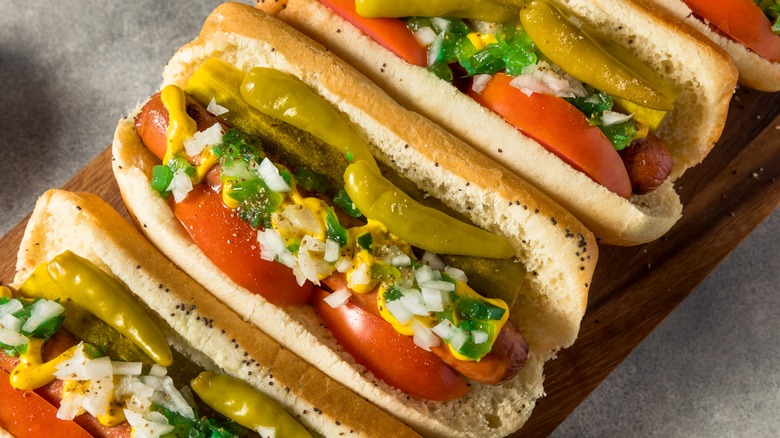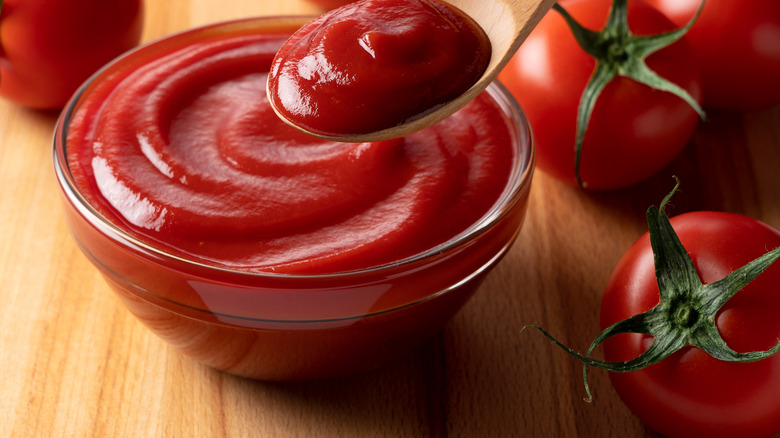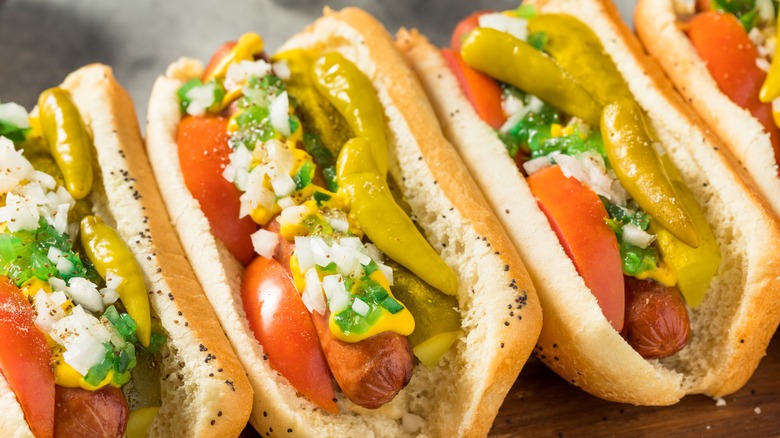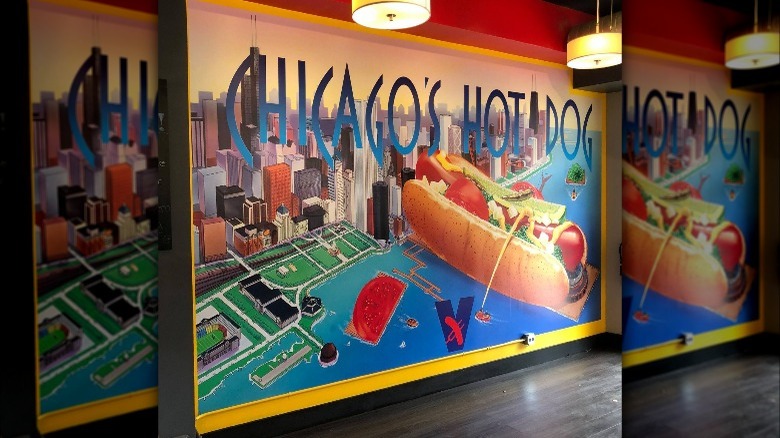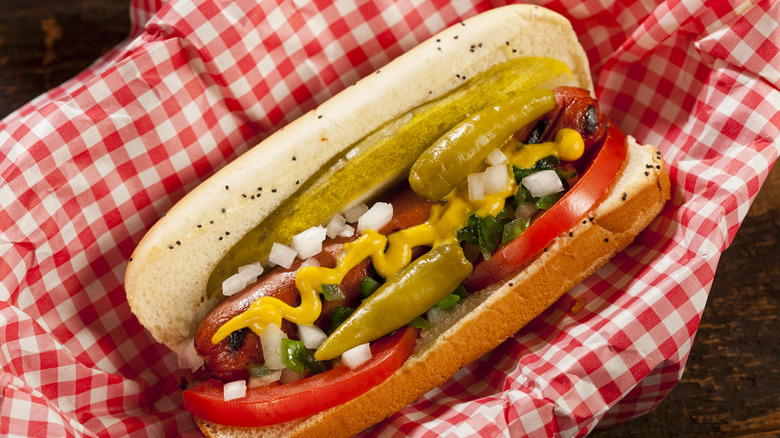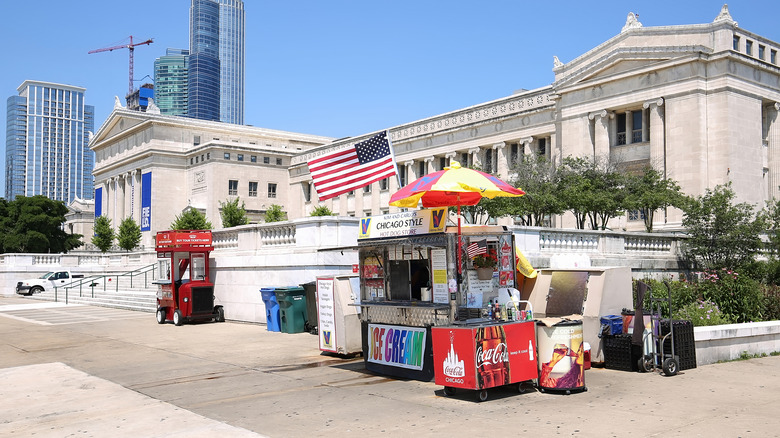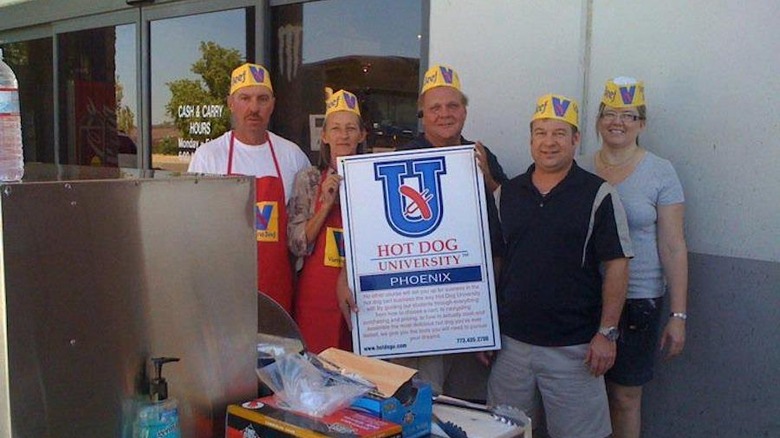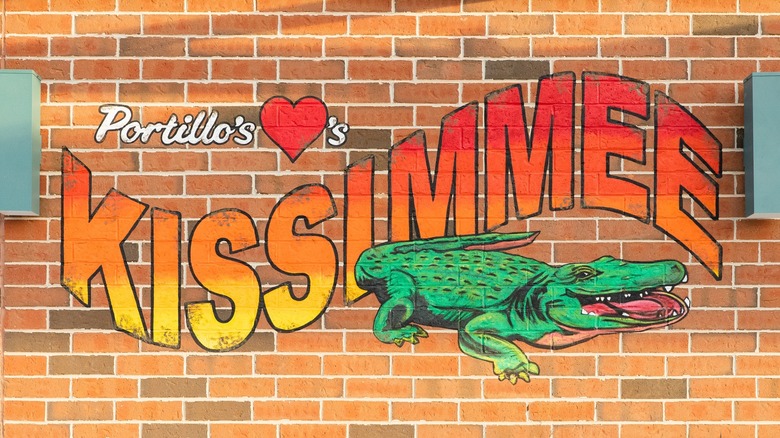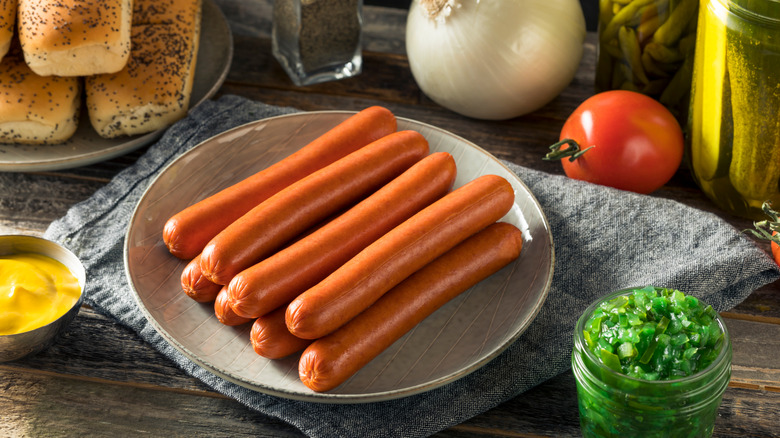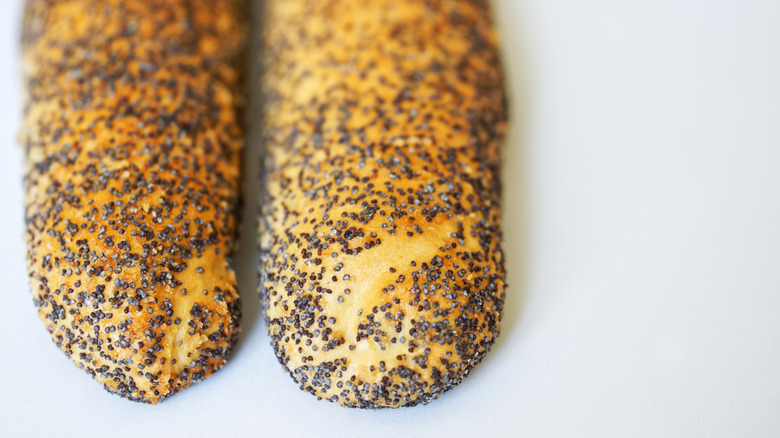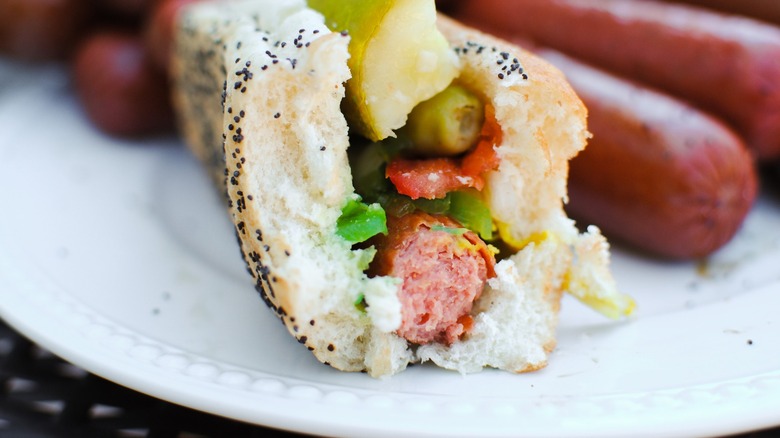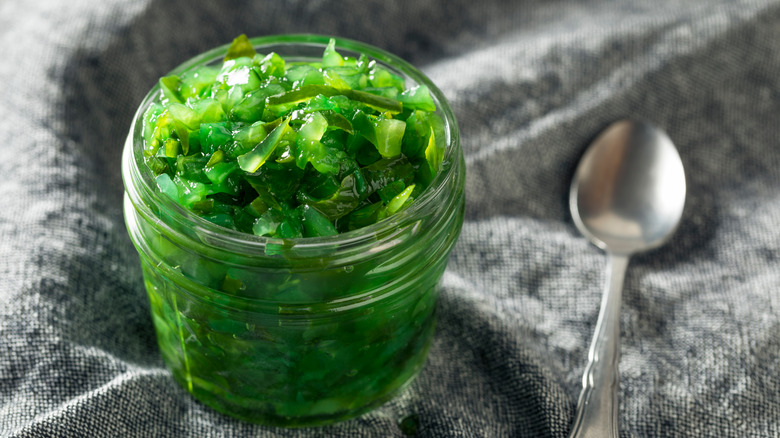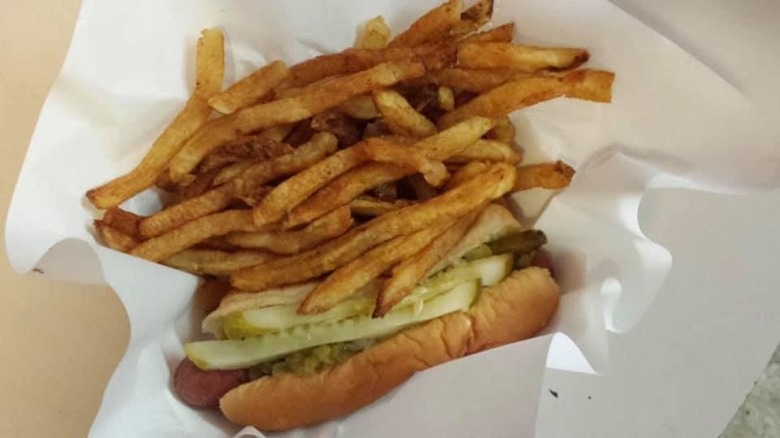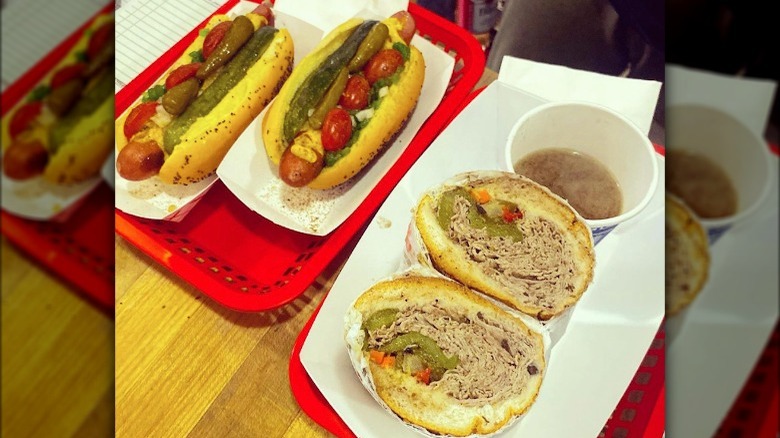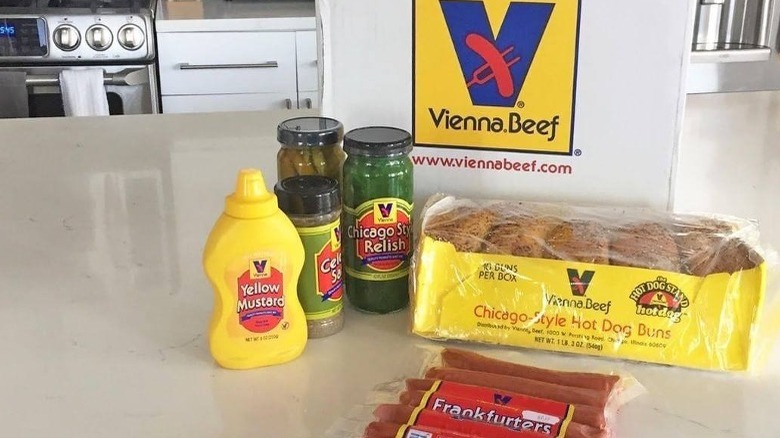14 Facts You Need To Know About The Chicago-Style Hot Dog
When it comes to beloved childhood foods, hot dogs are certainly in the conversation. They are easy to slice up and nestle in macaroni and cheese or enjoy as a corn dog rolled in delicious breading. Not to mention, some of us never lose our love of hot dogs, and thanks to many regional favorite hot dog styles, we can chalk up our obsession to nostalgia.
New York, for example, likes a hot dog with spicy brown mustard and either onions with tomato paste or even a bite of sauerkraut. Alternatively, Atlanta brings out the slaw to coat its hot dogs in, and Detroit prefers its hot dogs covered in chili with cheddar cheese and onion. They call it the "Coney Dog," and it's so messy you won't want to forget a stack of napkins. Then, of course, you have the Chicago-style hot dog. While other regional favorites include a focus on limited toppings of meat or other condiments, a Chicago-style hot dog is absolutely overwhelmed with toppings and condiments.
However, there's much more than meets the eye with these local favorites. It turns out that nearly every detail of the hot dog should meet specific criteria. Everything from how the dog sounds to the color of the relish is vital for a Chicago-style hot dog.
Leave off the ketchup
One of the most important rules when it comes to making a proper Chicago-style hot dog is to leave off the ketchup. While you'll enjoy many delicious toppings on a Chicago-style hot dog, ketchup simply doesn't belong.
This isn't just a matter of personal preference but a deeply ingrained part of Chicago's culinary culture. Chicagoans take their hot dogs seriously, and adding ketchup is considered a faux pas that can earn you some serious side-eye from locals. Even still, in 2017, Heinz attempted a clever ruse to rebrand its ketchup as "Chicago dog sauce" in an attempt to skate around Chicago's intense hatred for the condiment.
Though some secretly enjoy adding the red stuff to their dog, generally, it's considered too sweet for a largely salty and savory meal. An authentic Chicago-style hot dog typically includes a beef frankfurter on a poppy seed bun, topped with yellow mustard, chopped onions, neon green relish, tomato wedges, a pickle spear, and a sprinkle of celery salt. Combining these toppings creates a delicious balance of flavors with just the right amount of tanginess, saltiness, and crunch.
It's loaded with veggies
Perhaps the most unique aspect of the Chicago-style hot dog is its abundance of veggies. When ordering one of these iconic dogs, you may wonder what makes them so special, but upon unwrapping this crazy dog, you'll quickly realize that it's the toppings and condiments that really set them apart. While some of the included toppings are common (like mustard), some are far more exciting, like neon green relish and sport peppers.
These additions give the Chicago-style hot dog its distinctive flavor and texture. But they also make it a bit of a challenge to eat. With so many toppings piled high on a poppy seed bun, it can be a messy and unwieldy experience, but that's part of the charm of the Chicago-style hot dog. It's not meant to be a neat and tidy meal but a delicious and satisfying one. And the way the unique and oddly situated ingredients and condiments sit on the hot dog is what makes it stand out from the crowd.
Vienna Beef debuted at the 1893 World's Fair
In 1893, the windy city hosted the Chicago World's Fair. This event would also be the beginning of several other innovations like the Ferris Wheel. But, for the Chicago culinary scene, perhaps nothing was as big as the Vienna Beef hot dog. This now famous hot dog made its debut at the World's Fair, where Emil Reichel and Samuel Ladany launched it. They served the sausages topped with mustard and onions, which would become the precursor to the classic Chicago dog. Of course, the Chicago dog would eventually contain many more items, but all stars start someplace, after all.
Those hot dogs are the most commonly sold hot dog at stands around Chicago, with 90% offering the dogs. That's why they are also widely associated with the classic and ornately dressed Chicago-style hot dog. At Wrigley Field Alone, hot dog sales reach 17,000 at every game. It's clear how this city feels about its hot dogs.
This meal on a bun originated during the Great Depression
During the Great Depression, many struggled to find meals at reasonable prices. And while hot dogs were certainly popular prior to the Great Depression, the 30s saw the invention of this beloved dog as we know it today. For only a nickel, people would enjoy nearly a full meal with a sausage for protein, plenty of toppings as veggies, and even carbohydrates in the bun.
Obviously, the hot dog is tough to eat because the toppings create a rather unwieldy meal. But even still, its delicious combination of toppings and legacy during the Great Depression has made this beloved food a cultural icon for the city. It reflects the resilience and creativity of the city, and though the hot dog is less than 100 years old, its legacy will undoubtedly endure. After all, even today, people on the move in Chicago can find this meal on a bun throughout the city from delicious hot dog carts.
Some of the best dogs come from stands that offer a standalone hot dog
The next time you're searching for a great Chicago-style hot dog. Look for one factor: Can you purchase the hot dog on its own, without sides and a drink? Though this availability might seem like a minor detail, it actually speaks to the quality and authenticity of the hot dog. After all, many Chicagoans once purchased hot dogs as an inexpensive meal on their own, without the need for other sides. When you order a hot dog all on its own, you can enjoy the combination of flavors and textures distinctive of the Chicago-style hot dog. You'll be able to fully appreciate the pop of the sausage, the tanginess of the mustard, and the crunch of the celery salt.
Even if the stand offers the hot dog all on its own, it probably also has the option to purchase sides and a drink. While this is perfectly fine, for an authentic Chicago-style hot dog experience, consider enjoying the hot dog as its own meal and ordering another if you are still hungry.
Learn how to prepare a Chicago dog through Hot Dog University
When it comes to learning how to make a great Chicago dog, Vienna Beef offers a Hot Dog University, so you can learn from the company that has beef at most hot dog carts in Chicago.
The classes are taught by a Professor of Hot Dogs, Bill Murphy. He has lived in Chicago since birth and worked at the popular Murphy's Red Hots for many years. He is also a member of the Vienna Beer Hall of Fame. Through these classes, he offers instructions about how to make the hot dogs, the equipment you'll need, how to scout the perfect location, what you'll need to spend, the permits required for your business, how to be safe, marketing, and even creating quality video content. Since you'll be learning from a lifelong Chicagoan, the Hot Dog University offers attendees the know-how to make the popular Chicago dog.
Portillo's has helped popularize the famous hot dog across state lines
Even if you live far from Chicago and its iconic hot dog, you might still be close to your next great hot dog meal. Once exclusive to Illinois, Portillo's has ventured far outside the midwest to spread the good word of the Chicago hot dog.
You'll find locations as far south as Florida, out west to Los Angeles, and even right outside of Texas. Though it remains a largely midwest restaurant, its reach continues to expand. But even if no locations are close enough for dinner, with a bit of planning ahead, you can still procure a Portillo's hot dog by ordering your Portillo's to be shipped right to you. You'll need to ensure you have a crowd to feed because you can only buy the hot dogs in packs of 10 or 50. If you're ordering for delivery, don't forget the chocolate cake; it's the stuff of dreams.
Build the dog from the bottom up
In addition to looking out for a hot dog cart that offers the Chicago dog all on its own, be sure to also pay attention to how all the pieces are assembled. If you can find a hot dog cart that builds the dog from the bottom up, chances are, your dog will be pretty excellent.
Ideally, your Chicago-style hot dog should be assembled with the condiments being arranged according to their size as well as how they attach to the bun and even the sausage. A classic hot dog should begin with a layer of mustard on one side for hot dogs and, on top of that, a smattering of green relish. Sprinkled across the top, you will get crunchy onions with those tomato wedges nestled into the side. A pickle spear will go on the opposite side of the tomatoes, and a couple of sports peppers should sit on top of the dog. In the end, everything should get a sprinkling of celery salt. Rookies will often attempt to dress the bun rather than the dog, but what you're really in for is a nicely dressed hot dog, not a nicely dressed bun. Taking the extra time to find a hot dog cart that assembles the hot dog closest to this method will result in one that is cohesive and better maintains each topping's individual texture and integrity.
The dog and buns are steamed
Authentically prepared Chicago-style hot dogs certainly require specific toppings, but the necessary elements continue beyond here. For your hot dog to be genuinely in Chicago style, you'll also need to prepare your sausage and bun in a specific way — they should be prepared using steam.
Since hot dogs are fully cooked to begin with, this steam process is simply meant to warm the hot dog. Steaming will help enhance the flavor and maintain all of that juiciness. Never boil or grill your hot dog if it is going out of Chicago dog. Steaming the bun will create a more sturdy and flexible bun for carrying all those toppings. Since it will be able to hold everything it needs comfortably, this will also make your hot dog a little easier to eat. Not to mention, a steamed hot dog bun has a delightfully fluffy feel.
Be sure to note the snap
When eating a Chicago-style hot dog, one of the things you should look out for is the snap of the casing on your hot dog. A properly steamed hot dog should resist your bite down just enough to create a slight snap when it eventually separates. This is called "the snap," and it's one of those you-know-it-when-you-see-it deals.
Part of the reason Vienna Beef makes such great hot dogs for this Chicago favorite is its classic snap. The texture throughout the dog is smooth too. Other brands can sometimes have an odd texture and no snap, but a great hot dog should be consistent throughout. When choosing hot dogs to use for your next Chicago style, be sure to select the Franks rather than the larger-sized Jumbo Franks. If the hot dog is too big, the size can hinder the hot dog's ability to have that characteristic snap. Plus, the hot dog will take up too much room on the bun and leave less space for toppings.
The atomic relish has blue dye coloring
One of the first things people tend to notice about Chicago hot dogs is the overabundance of veggies and toppings on each one. Perhaps the next most distinguishing feature is the neon green relish. This bright relish came about in the 70s when blue food coloring was added to already green relish. The combination resulted in a color of relish that looks nearly inedible.
However, this atomic relish also has some immense appeal. In fact, a Chicago-style dog just won't be the same if you make it without this signature ingredient. This is why you find Vienna Beef selling neon-colored relish in grocery stores. However, there's a good chance that most customers purchase such a color of relish strictly for a Chicago-style hot dog. Of course, this shouldn't stop you from including it on other tasty foods that might need a little brightening up.
Dave's Red Hots is the oldest dog stand in Chicago
When it comes to selling Great Chicago-style hot dogs, perhaps no one holds that title more firmly than Dave's Red Hots. This restaurant got its start when Russian immigrant Dave Kaplan opened a hot dog shop in the 1930s. After a few failed attempts at opening other shops, Kaplan found success in a hot dog spot with Dave's Red Hots. Though the exact year is unknown, 1938 seems to be the agreed upon, reasonable estimation.
In 1941 the Karm family purchased the hot dog stand, and in 1971, Eugene Gaines bought the stand. Today, you can purchase Chicago-style dogs from this famous spot at 3422 West Roosevelt Road in Chicago. The prices couldn't be better at $4.25 for a hot dog with french fries, and though it's changed a bit over its substantial history, Dave's Red Hots retains an important place in the Chicago-style hot dog legacy.
Chicago hot dogs are finding their way to the big apple
Between pizza and hot dogs, Chicago and New York are constantly at odds with one another. Each believes they have the better option, and few are willing to fold on the issue. However, recently, Chicago-style hot dogs have started appearing in New York City.
Ten years ago, you would be hard-pressed to find a Vienna Beef dog anywhere in the big apple, but they have become more common thanks, in part, to Dog Day Afternoon in Windsor Terrace. This restaurant opened in 2021, and after proving that the dog would sell in New York, they now get regular deliveries of Vienna Beef. There are some differences between a classic Chicago dog and the one available at Dog Day Afternoon. For one, the restaurant uses sliced grape tomatoes rather than Roma wedges when needed. It may feel sacrilegious to enjoy a Chicago hot dog in New York, but the trend may eventually catch on with even more steam.
Make your own Chicago dog with a Vienna Beef kit
If, after all the Chicago-style hot dog talk, you find yourself in desperate need of a classic Chicago dog, have no fear because you have plenty of options. Of course, you could locate your nearest Portillo's and venture out for your hot dog, or you could have Vienna Beef ship a hot dog package right to your door.
With a Chicago-style hot dog kit straight from Vienna Beef, you'll get frankfurters, poppy seed buns, bright green relish, sports peppers, bright yellow mustard, and celery salt. This means you only need to supply the fresh ingredients like the diced onions, tomatoes, and pickle spear. The sets come in ten, and at the total cost of $54.95, That amounts to about a $5.50 hot dog. Or, you could hop on a jet and head to Chicago and brave the busy streets to find the perfect hot dog cart; the choice is up to you.
